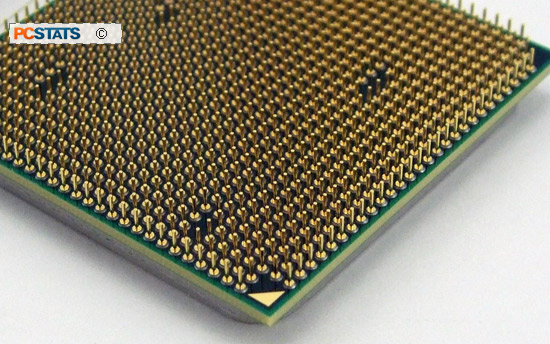We're going to assume you have a socket AM3 motherboard and socket AM3 AMD processor
at hand, both still in their boxes.
Step 1: Remove
the motherboard from its box and protective packaging. Place the anti-static
bag or foam mat under the motherboard to protect it, then lay the board down
on a flat space like a table.

Step 2: Gently but
firmly lift the sockets' metal lever up to prepare the socket to receive a processor.
This unlocks the AM3 socket and make it possible to insert a processor. Note
the location of the small triangle molded into one corner of the socket, this
is the processor alignment symbol. The processor has a similar triangle on both sides of
the PCB.

On a side note, the Socket AM3 socket is technically known
as a Zero Insertion Force (ZIF) socket. If you consider the force needed to
insert a simple two-prong wall plug in, it's not much, but
multiply that by 941-pins and you'd need a truck behind you to force all those
plugs in!
ZIF sockets alleviate this problem with microprocessors that contain hundreds
or thousands of contacts. The open ZIP socket doesn't make electrical contact
until the metal cam arm is closed and in that sweeping motion every
pin is slid latterly a millimeter or so into a V-shaped electrical groove, making
contact and locking the CPU in place. In the old days you'd need
a screwdriver to pry an Intel 486 chip out of
its socket. Some of you may remember doing this.... and the damaged chips and predictably bent pins
that resulted.
Moving along...

Remove the AMD
processor from its box and plastic clam shell packaging. Take off the
protective plastic chip carrier cover (if any) and hold the processor by its
corners. Now while holding the chip by its sides or corners, take a moment
to examine the underside of the AMD socket AM3 processor and inspect the
gold pins to ensure none are bent and that no
foreign material is present. If you see anything slightly out of position, the processor may
be damaged.

If a pin is out of place it may
be possible to very gently bend it back into alignment with the tip of
a pencil or other suitably clean and small implement. Note the
location of the little gold triangle in one corner of the
processor (it's printed on both sides of the chip). This is your processor
alignment symbol.
Holding the processor by
its sides, orient the chip so its small gold triangle faces the
small alignment triangle molded into the top of the AM3 socket. In
some cases a triangle
will be silk screened onto the PCB just outside of the socket as well. Lower the processor gently
and vertically down into the socket, ensuring that its pins mate with
the socket without any resistance. The CPU should literally drop into the
socket.
If it doesn't, check the CPU orientation and try
again. There's no need to force the CPU into the AM3 socket
whatsoever.

